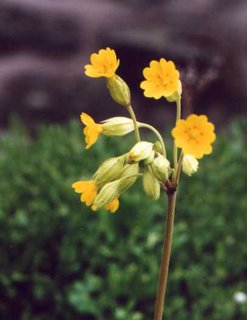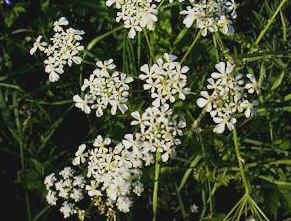http://martagon.blogspot.com/2006/08/literary-garden-enigmas.html
I went through the list of names:
1) Cowslips: These are known to me by my mum talking about seeing hundreds of them growing around rural Cirencester.They are primula Veris, with tall upright yellow flowers.

There is a discussion here of the cowslip in traditonal english folk medicine.The keys of heaven dropped by St peter (the flowers look like golden keys dangling down):
http://www.englishplants.co.uk/cowslip.html
2) Spring Primrose: Primula Vulgaris is a traditional spring flower, prima rosa.The first flowering one.It is pale yellow coloured like the dress description.
The website i found the information on is: http://www.plantlife.org.uk/uk/plantlife-discovering-plants-grow-wild-primrose.html
3) Cow Parsley: I see loads of this plant walking to work by the edge of a school field.Its other name is queen annes Lace.Someone wrote a blog post about that plant/flower before.Tell me if you know who did it, so i can link them..
It was called queen Annes lace according to this site because when she Travelled in May it flowers sprung up. Apparently its related to deadly nightshade..
http://www.arkive.org/species/ARK/plants_and_algae/Anthriscus_sylvestris/more_info.html
4) Michaelmas Daisys: These are actually cultivated and grown in many gardens i walk past.I guess its a traditional flower that has been cultivated for its cheery flowers, and the cool thing that they close their flowers in inclement weather, opening only for the sunshine.They look asleep when their flower buds are pulled close together. http://www.uksafari.com/michaelmas.htm.
The name comes from the traditional flowering date of September 29th, Saint Michaels feast.the warrior saint of Angels.
5) Dog Roses: Rosa Canina a scrambling hedgerow rose common in Britain.I see it in that wasteland bordering some houses.The pink flowers are so cute.You can make tea, syrup, or marmalade from the fruits (hips) after flowering.Picture to follow this post..
http://en.wikipedia.org/wiki/Dog_Rose
6) Last but not least the Bluebell wood. A common British literary theme.The bluebells grow beneath the tree canopies and cover the wood floor in a carpet of blue flowers.These are found all over Great Britain and Ireland.
http://en.wikipedia.org/wiki/Bluebell_wood
Blogger wont let me add more pics to this post, will add if after this.You have to look at the top two photos that i could not get on this page..
Intoxicated I hope you like this...i thought of you.


4 comments:
Wow! Thanks. Those are great images, particularly the primrose and the cowslips. I had different images of them in my mind. I'm glad to see these plants are still found in English fields; they are not common here, well not in Western New York, anyway.
I kinda figured about the Queen Anne's Lace connection.
The Cowslips are getting scarcer now due to their natural habitat being eroded away.There are companies who grow wild flowers to make seeds.You can grow woodland mix, meadow grasses, and every combination of wildflower.To try and keep the species going in a changing world.I did not expect them to be common in New York, although when i read heirloom gardens a lot of native english plants were taken to the USA by the colonists.
What a great idea for a post! Thank you! The Queen Anne's Lace is blooming all over the place here at the moment. The county has just mowed the roadsides (much to my disappointment...they were looking so pretty). They were made late because of all our rain earlier in the season. Blue Chicory is the other most common wildflower at the moment...a pretty combination. I've been planning a wildflower post all spring and summer, but haven't managed to get it done yet. One of these days....
I love to read English authors. All those old fashioned flower names and places, etc. give me such a cozy feeling :)
Cant wait Kerri.I have found that the wildflowers that grow all around me are just as pretty as the ones i grow in the garden.
The Ingenuity of man, and gardeners in particular has taken wildflowers and cultivated them.
I saw a man on Gardeners world who had been growing roses, and making hybrids for twenty years trying to perfect the rose, and then cultivate it.He made thousands of crosses but very few came out.That has become his life work to make a rose with a centre spotted face..
Post a Comment